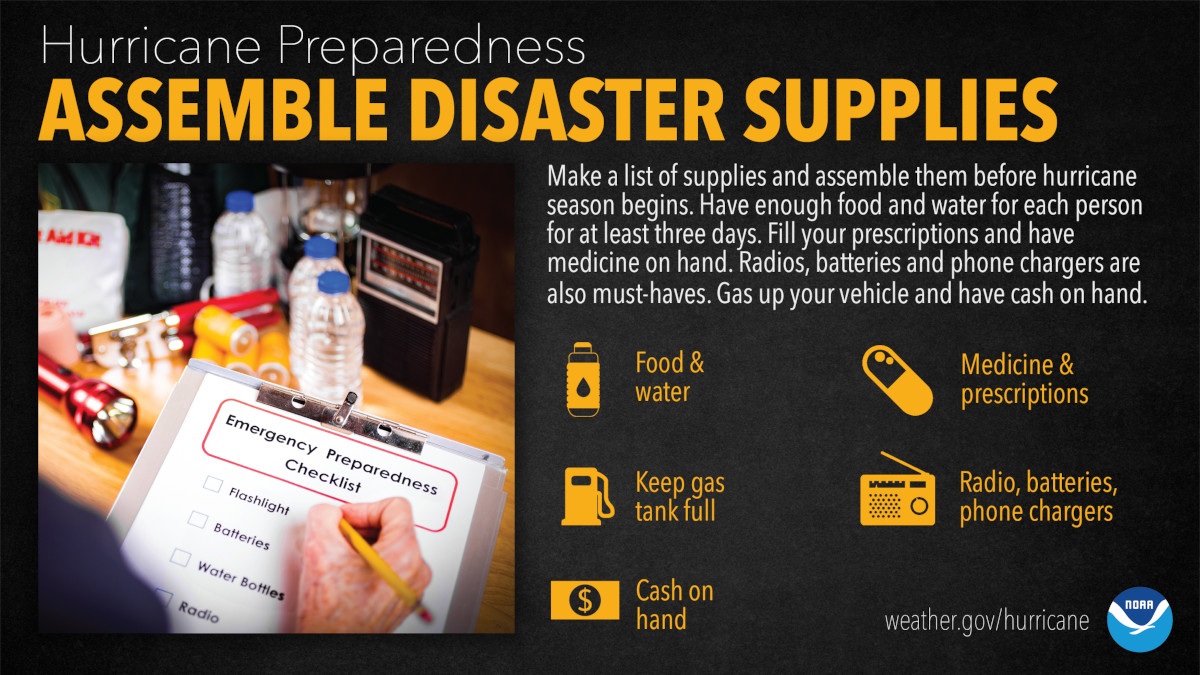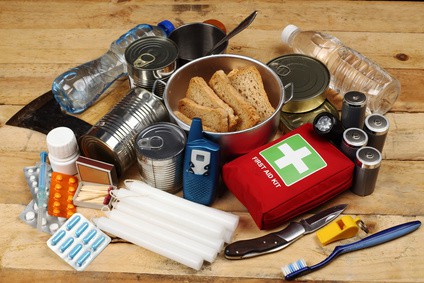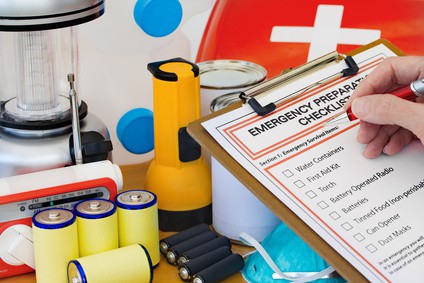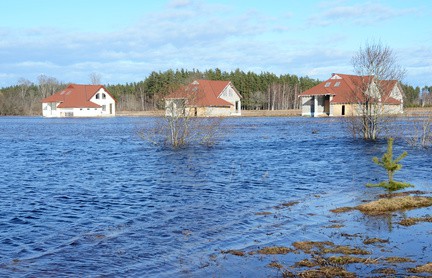Hurricane Preparedness: Disaster Planning and Preparation

Store at Least One Week of Non-Perishable Food, Water, Medicine, and other Supplies
Hurricane Preparedness Articles
- 7 Step Hurricane Preparedness Plan
- Hurricane Hazards and Risk Factors
- Make a Hurricane Evacuation Plan
- Hurricane Preparedness Kits and Supplies
- Hurricane Insurance Checkup and Updates
- Prepare Your Home for Hurricanes
- Help Neighbors with Hurricane Preparedness
- Complete Your Hurricane Preparedness Plan
- Emergency Preparedness Tips
- How to Prepare for a Power Outage
- 10 Tips to Survive a Hurricane Disaster
- FEMA Recommends a Generator
- Hurricane Disaster Preparedness
You're already assessed the the risks posed by hurricanes to your family and to your home and have begun to make a plan to mitigate those risks. You should plan for your family’s safety first. Property is replaceable. Family are not. Next you formed an Evacuation Plan, located evacuation routes and decided where you will go if ordered to leave. Whether you leave for higher, dryer ground or decide to stay, a Portable Disaster Supply Kit with everything you need should be next on your list of preparations.
The kit is portable because if you must evacuate, you can grab the kit and put it in the car. Close up the house, pack a few clothes, and then you are gone. If you decide to stay, you already have everything you need for the next week. Meanwhile, those have not prepared in advance are navigating overcrowded grocery stores and home improvements centers hoping they haven't arrived too late to purchase the food and supplies they need for the next week.
Assemble a Portable Disaster Kit
A portable disaster kit has everything required to leave in a hurry when a disaster threatens. Put all these items on a table to see how much space they take up, then purchase a portable container AND a five-gallon bucket with a lid to hold them all. A covered, plastic tub works well and keeps the contents dry. For portability, a large backpack or dry bag will also work.

Flashlights, Cell phone chargers, Battery-powered weather radio, and extra batteries for everything. LED flashlights use less power and batteries last longer. Purchase one small flashlight for each member of the family, plus a larger lantern-type light. Pack AC and DC cell phone chargers plus at least one quality external battery. Buy an NOAA weather radio that operates on AC, 12-volt car plug, and batteries. A tablet that accesses the internet through your cell phone could be a good investment.
Don't forget toothbrushes, toothpaste, and other personal items. Also include a small bottle of bleach for sanitizing. Store it in an opaque (not clear) bottle and label it with a permanent marker.
Shelter-in-place could mean anywhere, but usually it means inside your home. If you run into trouble during evacuation, having the right supplies could make a difference. Include a tarp to provide shelter from rain. If wind damages your roof, the tarp can keep you dry. The tarp can provide an emergency shelter if car trouble strands you on the road with no one can to help and flooding or other unforeseen circumstances force you to leave your vehicle. Store tarps, rope, heavy duty trash bags with ties, moist towelettes, a wool blanket or two, toilet paper, and duct tape in a five-gallon bucket with a water-tight lid. The bags should be large enough to line the bucket. Pack a whistle on a on lanyard for each family member to signal for help.
A first-aid kit is essential and contains more than band aids and sunburn cream. During a disaster, people get hurt and all too often it’s more than a scratch. A kit with a handy, visual guide can help with emergencies you haven’t seen before or are not sure how to treat. Add dust masks to the kit. If your building collapses or partially collapses, use the dust masks to avoid breathing dangerous dust particles.
Tools are essential. Hammer, screwdriver set with various bits. Pliers, self-adjusting pliers, wrenches, locking pliers. Check your gas and water utilities, find the correct size wrench or tool, and add them to your disaster kit. In the event of a leak or worse, you can turn them off at the source. Better still, buy an extra of each size needed for utility shut off and keep it near the valve.
Make a local map a part of your disaster kit. Don’t rely on your cell phone or GPS. Buy a recently updated map and keep it in a plastic zipper bag where it will stay dry. Highlight evacuation routes and possible alternatives.
Store a fireplace or BBQ lighter, candles, and strike-anywhere kitchen matches in a plastic zipper bag. Add a dozen cans of gel-fuel. In a small space, a few candles can make a significant difference. While sheltering at home, a few three-wick candles will help with heat and light. Candles also help children and adults feel more at ease and in control of their situation.
Top 5 Generators for Hurricane Power Outages
Food and water
Each person in your family needs at least one gallon of water every day for drinking and another gallon for hygiene. Three or five-gallon containers are portable and easily filled and used. One case (24) of 500ml bottles of water equals just over three gallons. In the hours before a hurricane makes landfall, local stores will run out of bottled water. Store your own and don’t rely on local stores to provide it just before a disaster strikes.

Non-perishable food comes in two basic forms. Canned and dried. Canned foods can last a long time, but they are heavy and take up space. Dried meals need water to rehydrate them. Some you will want to heat up. A small collapsible stove that runs on gel fuel with a small pot is enough to get by. Gel fuel comes in the small cans and often seen below hot foods on a buffet table to keep food hot.
Choose a variety of foods that everyone likes to eat. Soups, stews, canned meats and fish, and vegetables. Don’t worry about bread, but consider potato flakes and rice or other grains. Take into consideration that different family members have different needs. Stock baby food it you have a baby. Someone may have a special dietary need or food allergy. Make a list that will provide enough food for one week.
Throughout the year as you do the family shopping, buy more items on the list and rotate new food items into your stored disaster supplies.
With all the other dangers and risks to consider, don’t forget about food safety. Use disposable plates and utensils to conserve water. Wash anything not disposable in hot water with dish soap. Soak food or water containers in a solution of one teaspoon bleach to one quart of water for 30 minutes, then air dry.
You can also sanitize clear tap water with 1/8 teaspoon bleach to 1 gallon of water for drinking. Do not use scented bleach or bleach with anything added.
Refrigerators will become too warm to keep food safe after four hours. Freezers make keep everything frozen for 12 to 24 hours. Keep the doors closed, but after a day, you’re probably going to throw all that food out. Better to cook it ahead of time than try to store it raw. An emergency supply of power used judiciously will keep your food safe as if there was no outage.
With an emergency supply of power, you can cook food in a slow cooker, microwave, or electric fry pan.
Best Natural Gas and Propane Generators for Whole House Power
No Plumbing?
It’s a fact. After a disaster that includes flooding and storm surge, local utilities we take for granted may not work. One result is that flushing the toilet may turn into a disaster of its own. Eventually, everyone must go and over the course of three to five days, lack of a working toilet may pose a serious waste disposal problem.
A five-gallon bucket lined with a heavy-duty, water-tight garbage bag makes a serviceable toilet and a water-tight lid controls odors. Seats for five-gallon buckets are available at outdoor sporting goods stores, big box outlets, and disaster supply websites.
At the end of the day, remove most of the air from the bag, tie it shut with an overhand knot, then add a heavy-duty twist tie below the knot and make it tight. Store with your trash.
Don’t forget that family pets have needs too and taking them for a walk outside during or after the storm is dangerous. Cats can still use the litter box—put it in the room where you will shelter—and dogs may do better with the absorbent pads available at pet stores. With the right pump, your aquarium may run on a battery for days.
Need to Know: Portable Generator vs Home Standby
Emergency Power
FEMA, the Federal Emergency Management Agency, recommends that every home have a portable generator for emergency power. When the power goes out, essentials such as refrigeration, lights, phone chargers, freezers, sump pumps, and electric ranges or microwaves no longer work.
A standby generator is the easiest option, especially to power an entire home. They operate automatically during an outage and run on natural gas or propane, which eliminates the need to store fuel. Standby generators provide power for your home’s air conditioning, furnace, and even well pumps. You won’t get that with a portable generator that connects to appliances with extension cords.
A portable generator will keep your refrigerator and freezer cold—important for food safety—and your sump pump running which keeps your basement dry and helps prevent mold. If you want to run a furnace or central air conditioner, a portable needs a manual transfer switch because these appliances are permanently wired.
Never operate a generator in a home, garage, shed, indoors, or in any enclosed space. Always place portable generators at least ten feet from the home and never where exhaust fumes can enter through any window, vent, or door. Even a window opened just one-half-inch for an extension cord can pull exhaust fumes into the home and kill those inside. Carbon monoxide is odorless, tasteless, and invisible, and is deadly.
Read About the Safe Use of Portable Generators
Portable generators usually operate on gasoline, although some propane models are available. During a long-term outage following a disaster, fuel efficiency is a primary concern because fuel becomes difficult to obtain. Supply routes are shut down, travel is limited, and gas stations may not have the power they need to pump fuel.
Many local codes limit residential storage to 25 gallons or less. That may not last very long depending on the size and type of your generator, and on how much power you use. A modest 6500 watt portable could use seven to eight gallons in 10 hours running at just half the load capacity of 3000 watts.
On the other hand, a 2000-watt inverter generator will only use 2 gallons of fuel in eleven hours. Judicious use could make a 25-gallon supply last a week. And if you need more power, a parallel kit allows you to connect two inverter generators together to supply double the power.
Store fuel in approved containers and use a gasoline stabilizer. Rotate a container of fuel every two or three months by adding it to your vehicle. Refill the container when you refuel your car. Don’t forget to add stabilizer each time you fill the containers. Stabilized fuel stays fresh for at least a year, but by the time a year is up, you will have used all the fuel through your vehicle and replaced it.
How to Use a Portable Generator for Emergency Power
Portable Generator Safety Rules to Live By
Insurance
Everyone has homeowner’s insurance or renter’s insurance, but what about flood insurance? Did you know your homeowner policy does not cover damage from a flood or storm surge? It may not even cover you if your sump pump fails. The sad fact is, many people find out that their home was not covered by flood insurance after it was destroyed by a flood of some kind.
Insurance companies base their rates on risk. If a hurricane is headed for your coastal town, insurance company won’t add insurance or allow you to make significant changes to your policy. Do a review of your insurance. Talk to your agent and ensure that you have enough coverage to replace your home in the event a hurricane or other disaster destroys it.
Flood insurance is purchased through an agent, but is part of the National Flood Insurance Program through the Federal Emergency Management Agency (FEMA). Flood insurance does not take effect until 30 days after your pay for the policy. If your company does not offer flood insurance, call the NFIP Referral Call Center at (888) 379-9531.
With all your preparations made, the unwelcome advance of a tropical storm or hurricane won’t leave you unprepared. Assemble your kits. Make plans. Share them with family and friends. Don’t forget to include a way to keep in touch with extended family and those who don’t live with you.
Portable Generators vs Inverter Generators
Updated August 7, 2020

